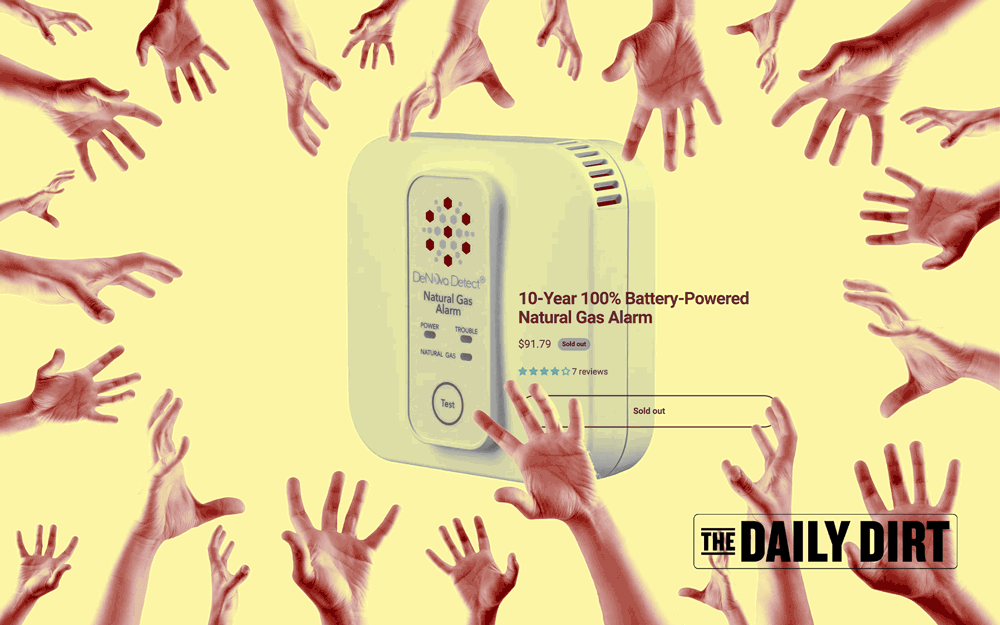Last week, the New York Apartment Association started getting a lot of calls about Local Law 157, which the City Council passed in 2016.
Its landlord members had read an article in The Real Deal speculating that the law, which requires gas detectors in apartments with gas appliances by May 1, 2025, could cause major problems by prompting gas shutoffs that take forever to resolve.
Why the rush, with the deadline six months away? Because the Department of Buildings requires UL-certified detectors, and the NYAA has identified only one, a DeNova Detect model, that meets that criterion and is also battery-powered.
“I suspect if orders get in early, it won’t be a problem complying with the May 1 deadline,” a spokesperson for NYAA said. “But if owners wait until April, there will probably be supply chain issues.”
Local Law 157 requires detectors near gas appliances in all multiple dwellings, one- and two-family homes occupied by someone other than the owner, and Class B dwellings, such as hotels.
New York City has more than 2.3 million rental units and 3.6 million apartments overall. Nearly 90 percent of New Yorkers use natural gas at home. It’s quite possible that landlords, co-op shareholders and condo unit owners will try to order millions of these DeNova devices, which cost $91.79 apiece.
On Tuesday, DeNova’s 10-year detectors were sold out. But they appeared to be back in stock on Wednesday. Another company, Pepco, has a similar product, which comes with monitoring. Its website is counting down the days to the May 1 deadline and warns owners to “avoid price hikes and detector shortages.”
What about getting a plug-in model instead? The NYAA doesn’t recommend that, as the devices must be installed one foot below the ceiling, and between three and 10 feet from each gas stove and dryer. Also, tenants could unplug them, leading to violations.

“What we hope is that the City Council understands that this is going to raise rents, and for rent-stabilized buildings, the Rent Guidelines Board is going to need to account for this added expense,” said NYAA head Kenny Burgos on the group’s podcast.
Fixing undetected small leaks discovered by the new devices could be costly.
“We fear this law is going to lead to massive expenses for older, rent-stabilized buildings in the outer boroughs,” Burgos said.
What we’re thinking about: Is Mayor Eric Adams angling for a pardon from Donald Trump, or for a Trump-appointed attorney general to withdraw his indictment? Send your thoughts to eengquist@therealdeal.com.
A thing we’ve learned: Laundry, if not outsourced, typically accounts for about 25 percent of a hotel’s energy use. Bruce Becker, developer of New Haven’s Hotel Marcel, found ultra-efficient commercial dryers with heat pumps, but they weren’t available in the U.S. He was eventually able to buy them from Sweden. “The payoff time is something like six months — it’s crazy. This saves us a ton of money,” he told a Yale publication. “If the whole hotel industry would shift, within a couple years the industry could actually meet its emissions reduction targets.”
Elsewhere…
For readers who saw my piece on the Assembly District 1 race on Long Island’s East End but missed the result, the winner (by 12 points) was Democrat Thomas Schiavoni. He had been slammed by opponent Stephen Kiely for supporting two affordable housing developments in the Hamptons.
Kiely had said he grew up in the “suburban hell” of Suffolk County hamlet Selden but moved to the North Fork and was inspired to run for state office when Gov. Kathy Hochul proposed allowing 1 percent annual housing growth, even if localities objected. Kiely had run for three other seats before Hochul unveiled her plan, which she dropped in April 2023.
* * *
Ever wonder what is the total value of commercial real estate in the U.S.? No?
Just in case, Clarion Partners and Rosen Consulting Group came up with a number: $26.8 trillion. The institutional-quality portion of that is 44 percent, their report found, including $2 trillion in residential alternatives (single-family rentals, student housing, age-restricted housing, and manufactured housing).
The report also breaks out the investible CRE universe into traditional sectors (office, retail, multifamily, hospitality and industrial), worth $17 trillion, and alternatives (data centers, self-storage, senior housing, life science, cold storage, etc.), worth $10 trillion.
Closing time
Residential: The priciest residential sale Wednesday was $37.6 million for a 5,718-square-foot condominium unit at 250 West Street in Tribeca.
Commercial: The largest commercial sale of the day was $4.2 million for a 12,769-square-foot lot at 974-990 Meeker Street in Greenpoint. The property has an industrial building and parking.
New to the Market: The highest price for a residential property hitting the market was $14.9 million for a 3,300-square-foot co-op at 1067 Fifth Avenue on the Upper East Side. Jane R. Andrews and John Cronin of Coldwell Banker Warburg have the listing.
Breaking Ground: The largest new building application filed was a proposed 27,213-square-foot, 10-unit, mixed-use project at 36-31 31st Street in Long Island City. Permits were filed by Gerald Caliendo. Aditya Shah and Palwinder Singh purchased the vacant land in September for $3.4 million. — Matthew Elo
